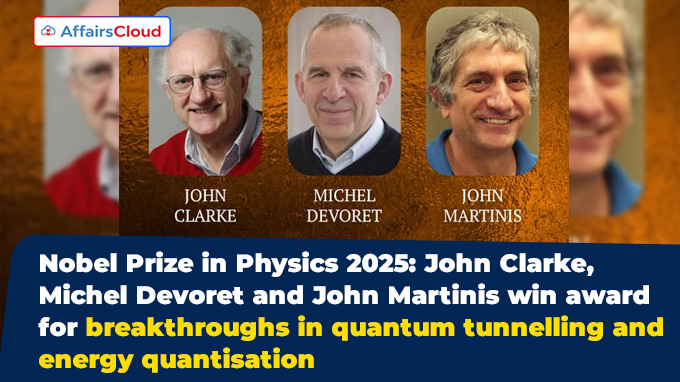On 7 October 2025, the Royal Swedish Academy of Sciences awarded the Nobel Prize in Physics jointly to British physicist John Clarke, French physicist Michel Henri Devoret, and American physicist John Matthew Martinis for their discovery of ‘macroscopic quantum mechanical tunnelling and energy quantisation in an electric circuit’, in Stockholm, Sweden.
- The laureates demonstrated that quantum mechanics governs macroscopic systems, with Josephson junctions underpinning quantum computers, flash memory, and ultra-precise quantum sensors.
Exam Hints:
- What? Nobel Prize in Physics 2025
- Organiser: Royal Swedish Academy of Sciences
- Laureates: John Clarke, Michel Henri Devoret, and John Matthew Martinis
- Recognition: For their discovery of macroscopic quantum mechanical tunnelling and energy quantisation in an electric circuit
- Prize Components: Gold medal, diploma, and 11 million SEK cash (2025)
- 2024 Laureates: John J. Hopfield and Geoffrey E. Hinton
- Indian Physics Nobel Winners: C.V. Raman (1930) and S. Chandrasekhar (1983)
Significance of the Discovery:
Experiments: Conducted in the mid-1980s, using a chip-based Josephson junction built from superconductors.
Observation: Demonstrated quantum tunnelling and energy quantisation, showing that macroscopic systems can exhibit quantum behaviour.
Impact: Laid the foundation for next-generation quantum technologies, including quantum computers, quantum cryptography, and quantum sensors.
Winners of Nobel Prize in Physics 2025:
| Nobel Laureate | Awarded for |
|---|---|
| John Clarke | Discovery of macroscopic quantum mechanical tunnelling and energy quantisation in an electric circuit |
| Michel Henri Devoret | |
| John Matthew Martinis |
About the Laureates:
John Clarke: British physicist and Professor of Experimental Physics at the University of California, Berkeley (California), United States of America(USA).
- He led the research group where key experiments linking quantum phenomena with superconducting circuits were conducted.
John M. Martinis: American physicist and Professor of Physics at the University of California, Santa Barbara (California).
- His Doctor of Philosophy(PhD) research, supervised by John Clarke, focused on macroscopic quantum tunneling (MQT) and energy-level quantization (ELQ) in a current-biased Josephson junction.
Michel H. Devoret: French physicist, F. W. Beinecke Professor of Applied Physics at Yale University, United States of America (USA), Director of the Applied Physics Nanofabrication Lab at Yale, and currently Chief Scientist at Google Quantum Artificial Intelligence (AI).
- He is known for pioneering studies on macroscopic quantum effects in superconducting circuits, demonstrating in the 1980s that such phenomena can occur in hand-sized circuits.
About Nobel Prize in Physics:
Medal Design: The Nobel Prize medal was designed by Swedish sculptor and engraver Erik Lindberg.
Medal Imagery: It features the Goddess of Nature, Isis, rising from clouds and holding a cornucopia, while the Genius of Science lifts the veil that covers her face.
Medal Inscription: The medal bears the Latin phrase “Inventas vitam iuvat excoluisse per artes”, which translates to “Advancing human life through the arts of discovery is beneficial.”
Nobel Prize: Administered by the Nobel Foundation in Stockholm using Alfred Nobel’s fortune, have been awarded since 1901 in Physics, Chemistry, Physiology/Medicine, Literature, and Peace, with the Sveriges Riksbank Prize in Economic Sciences added in 1968.
Prize Details:
- Components: Includes a gold medal, personal diploma, and cash award.
- Cash Award: Swedish Kronor (SEK) 11 million, shared among the three laureates.
Facts of Nobel Prize in Physics (1901–2025):
Total Awards: From 1901 to 2025, 119 Nobel Prizes in Physics were awarded to 230 laureates.
Distribution of Prizes:
- Single Laureate: 47 prizes
- Two Laureates: 33 prizes
- Three Laureates: 39 prizes
Years Not Awarded: The prize was not awarded in 1916, 1931, 1934, 1940, 1941, and 1942.
Multiple Laureates: John Bardeen is the only individual to have won the prize twice—in 1956 and 1972.
Female Laureates: Only five women have received the prize: Marie Curie (1903), Maria Goeppert Mayer (1963), Donna Strickland (2018), Andrea Ghez (2020), and Anne L’Huillier (2023).
Youngest Laureate: Lawrence Bragg was 25 years old when he received the prize in 1915.
Oldest Laureate: Arthur Ashkin was 96 years old when awarded in 2018.
Posthumous Awards: Since 1974, the Nobel Foundation’s statutes stipulate that a prize cannot be awarded posthumously unless the laureate has died after the announcement.
2024 Nobel Prize in Physics: American physicist John J. Hopfield and British-Canadian computer scientist Geoffrey E. Hinton were jointly awarded the Nobel Prize in Physics 2024.
Indian Nobel Laureates in Physics:
Chandrasekhara Venkata C. V. Raman: Born in Tiruchirapalli, Tamil Nadu(TN), became the first Asian and non-white scientist to win a Nobel Prize for Physics in 1930 for his discovery of the Raman Effect while conducting research at the Indian Association for the Cultivation of Science, Kolkata, West Bengal(WB).
- He became the first Indian recipient of the Nobel Prize in Physics.
Subrahmanyan Chandrasekhar: Born in Lahore and educated in Chennai and Cambridge, was awarded the 1983 Nobel Prize in Physics for his work on stellar structure and evolution, including the Chandrasekhar Limit, which revolutionized our understanding of white dwarf stars.
Click here for more information about the Nobel Prize





